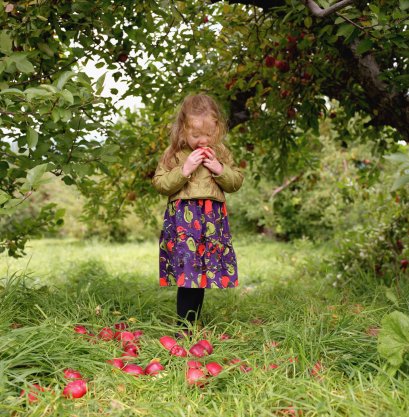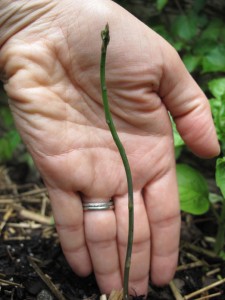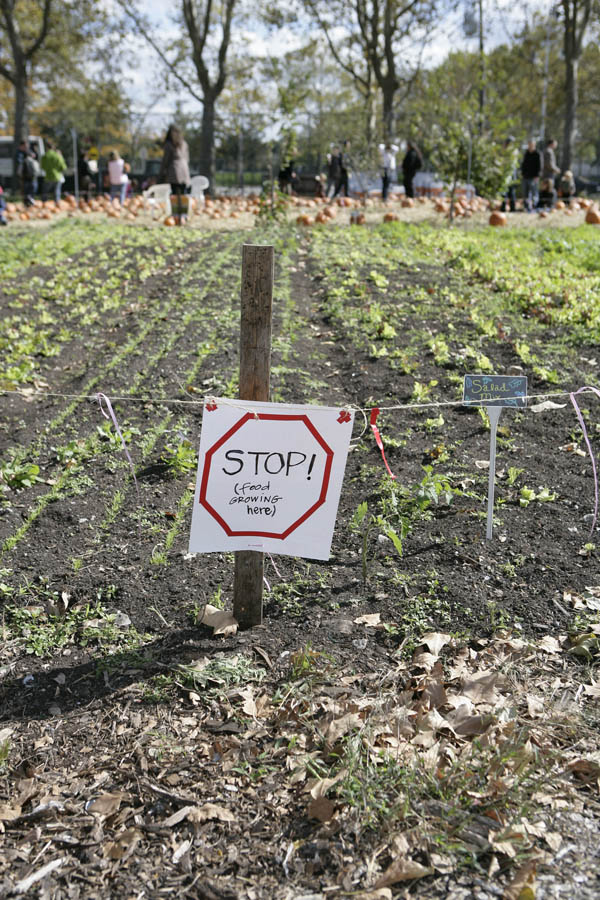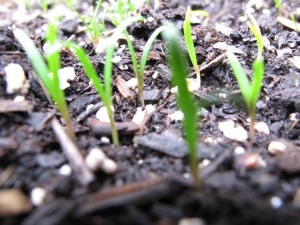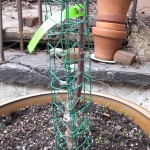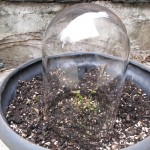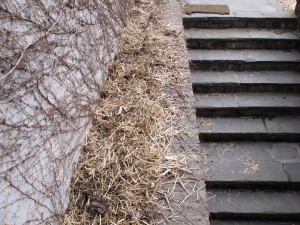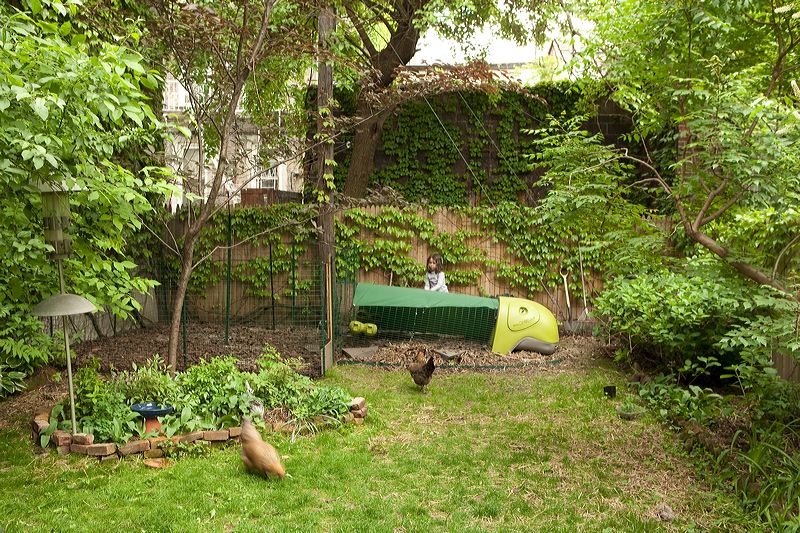
Almost a year ago my family decided to get chickens for our urban backyard. I thought I would write about our experiences because of the growing interest in backyard chicken-keeping.
After reading and researching and convincing my family, we ordered three day-old chicks to start our backyard flock. If you aren’t familiar with ordering livestock, it arrives via the United States Post.
Last July I got a call from my local post office saying that our chicks had arrived and in less than 10 minutes the mailman was at our door with a box emitting tiny peeping noises. I think he was happy to pass off this noisy box and get on with his regular, less-insistent packages!
Most hatcheries that sell mail-order chicks have a minimum order of 24 chicks. The large numbers of chicks in the box help keep them warm, which is crucial for the babies survival. These minimums are large enough that it prevents most hobbyists from ordering. Some people solve the problem by splitting their orders with friends. This is a great solution, but sometimes hard to coordinate. Mypetchicken.com stepped in to help urban chicken keepers. For people living in urban centers, they offer a minimum order of 3 chicks. They have special packaging that has a cushioning nest, green nutritious/hydrating gel and they include a heat pack if the weather is cool. Since my order came in July, they didn’t need to include the heat pack. Here’s a photo of my chicks when we opened the box.
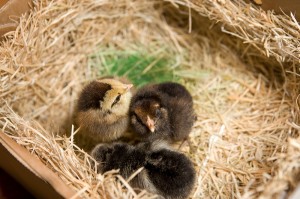
our 3 day-old chicks in the box they were mailed in
The chicks need some special care when they first arrive. They can be very stressed from the journey, and will need to have access to water immediately. You can gently dunk their beaks in their water dish to teach them where to find water. Also check their little butts to make sure they aren’t pasted up with droppings. The chicks need to be kept in a special place called a brooder that is warm and away from drafts. You should have the brooder already set up for their arrival. The brooder can be an old aquarium, cardboard box, Rubbermaid tub…you get the idea. I made mine out of an old hamster cage and put cardboard around the sides to protect from drafts and paper towels on the bottom to keep them from slipping on the plastic. I bought a heat lamp from my local hardware store.
To feed them you will need chick crumbles and fresh water (very shallow, so they can’t fall in and drown). They need to be warm. A guideline is 90-100ºF the first week and then 5ºF less each week. Check on how they act . If they are panting and huddling away from the heat source, it’s too hot. If they are mashed together in a ball under the light, it’s too cold. Take a peek at backyard chickens for more detailed instructions on raising your chicks during their first 60 days.
The chicks sleep a lot and will sometimes just sort of fall over. This can be a little disturbing to a newbie because it looks as though they’ve just keeled over.
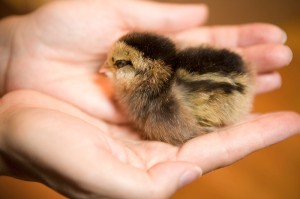
This little one is Edie. She’s the sweetest of the group. On her first day I held her for a few seconds and she drifted off to sleep in my hands. She’s what’s known as an Easter Egger chick, which is a mixed breed derived from the Araucana chicken. Easter Eggers aren’t a pure breed, but they have the same blue-green colored eggs of Araucanas.
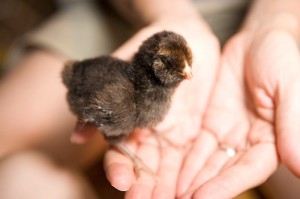
Louise or LouLou for short
This little pee-wee is LouLou and she’s an Easter Egger also. There is a huge variation of coloring with Easter Eggers. Interestingly enough, their coloring as chicks may bear little resemblance to their adult coloring. LouLou is the loudmouth, bratty little sister of the group. When her sisters are asleep, she chirps her head off to wake them up. I don’t know if her motivation stems from loneliness or sadism, but she’s got quite a personality. Despite her size, I’m putting my money on her to be the top of the pecking order.
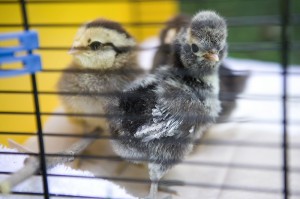
Andie and gang at 4 days
The gray one is Andie. She is a silver laced polish chick and will look like this when she grows up. The big pompom “hairdoo” she will get reminded us of Andy Warhol’s hair, so we kind of went with a theme of Andy Warhol’s Factory. LouLou is named for Lou Reed. Edie is for Edie Sedgwick and of course Andie is Andy Warhol. We joke that we have factory eggs, although these gals will be the farthest from factory hens you can imagine.
4 Days Old:
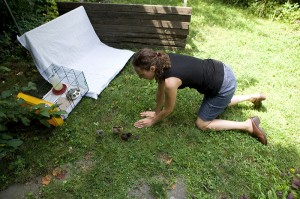
the chicks outside of their brooder for the first time
The rate of the chicks growth is amazing. Since the weather outside was as hot as their brooder, we decided to take them outside for a photo shoot. We put a blanket down to make a little photo sweep backdrop and put down our picnic table and brooder to try and keep them somewhat contained. They were pretty freaked out after my bumping them down our spiral staircase to the outside and kept very close to me. I think they see me as mama hen, which warms my little heart.
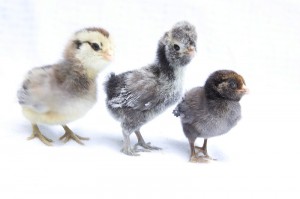
Edie, Andie and LouLou
You can get a pretty good idea of their respective sizes. LouLou is a little crouched down, but she’s definitely the smallest of the bunch. What she lacks in size, she makes up for in pushiness. You can see the tips of wing feathers starting to come in on Andie.
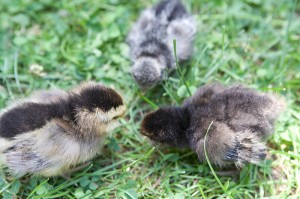
Once the girls got used to their new surroundings, they really started enjoying themselves. They had a blast pecking at the grass and scratching around on the ground. We’re going to take them outside for a few minutes each day to let them get used to the outdoors.
10 Days Old:
It’s been fascinating to watch the changes the chicks have already gone through. In their second week they have tripled in size, started to scratch the ground and learned to fly about 2 feet off the ground. They have quite a lot of feathers on their wings and have started to get silly little tail feathers. They start to look really mangy when their true feathers start peeking out of their baby fluff. It will be pretty hilarious to see how scruffy they look when the feathers on their necks and faces start to come in.
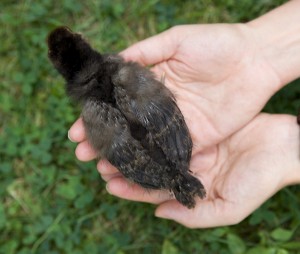
LouLou getting wing and tail feathers
LouLou has overtaken Andie in size and is still my bet for dominant hen. I’m crossing my fingers that she doesn’t end up being a rooster. I paid extra to get “sexed chicks” because roosters are illegal in NYC. There’s actually a job where someone looks at day-old chicks and determines their sex. They have a 90% accuracy rate. I read on a chicken forum the saying, “if it lays it stays and if it crows it goes”, which will certainly hold true here. I’m crossing my fingers that we have all girls because I’ve grown so attached to them.
Okay, now that I’ve just admitted I read chicken forums (or chicken porn as my husband refers to my late-night internet chicken research), I will attempt to distract you with cute chick photos…
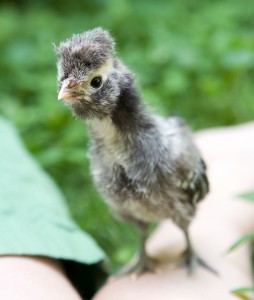
Andie looking like an ostrich
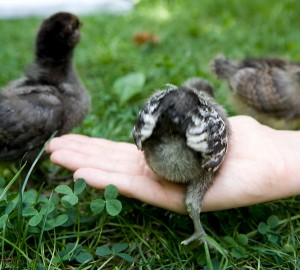
fuzzy butt
3 Weeks Old:
We’re going to stay at my in-law’s home in the Berkshires and are bringing the chicks with us. They are almost 2 weeks old and we’ve upgraded to a dog crate to accommodate for their exponential growth. We’ve nicknamed our minivan “gypsy” because we are now traveling with livestock. I guess goats will be next!
In the meantime, take a peek at some beautiful pen and ink drawings of chicks growing up by Kip Mieke Roth.
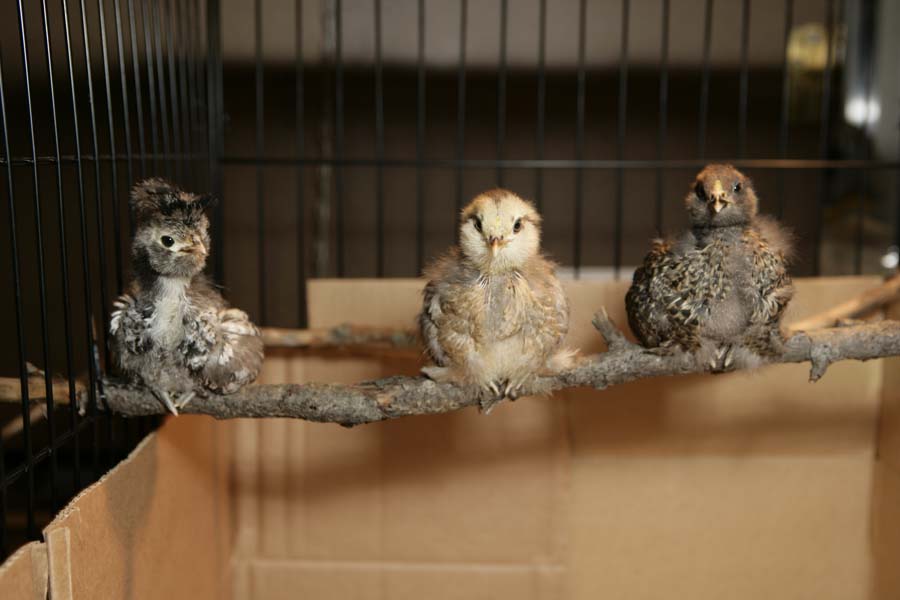
We found a nice stick to use as a perch on one of our nature hikes in the Berkshires. They immediately hopped on and now sleep on their perches. At 3 weeks, they have a lot of feathers, but still need the heat lamp until their feathers have filled in a bit more. I only turn it on at night when the temperature drops. The cardboard around the bottom of their cage isn’t so much for drafts as it is to keep the mess down. Chickens love to scratch! These girls dig and scratch and kick around in their pine shaving bedding and have a grand old time. The mess they make with the shavings is pretty impressive, and since we’re staying at someone else’s house, I want to do my best to keep the mess down. They look less like chickens to me and more like owls or some sort of forest creature. Andie is sporting a very ratty looking mohawk.
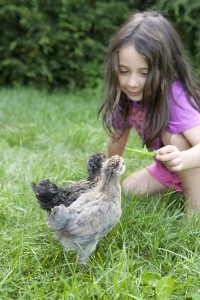
Lindsay playing with the girls
Our daughter Lindsay is really enjoying the chicks. She is 4 years old and is very gentle with them. I’m less worried now that they have grown so much in size. LouLou is on the left and Edie is on the right. They have gotten most of their feathers in the days between 2 and 3 weeks. They enjoy munching on grass and eating the mosquitoes that I smack on my legs and hand to them. Gotta give them a taste for those buggers!
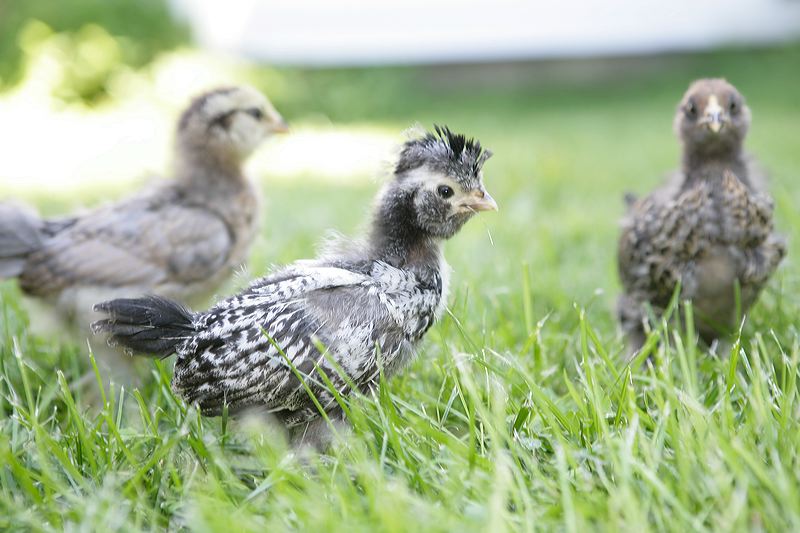
6 Weeks Old:
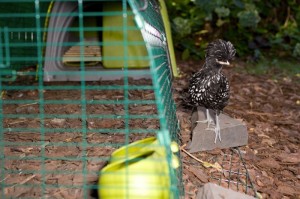
Andie next to the coop
The coop arrived a few weeks ago and the girls are now used to living outdoors. We ordered The Eglu by Omlet, which is probably one of the fanciest coops on the market. Part of the stipulation (from my once-skeptical husband) of getting chickens was that our backyard shouldn’t look like a run-down barnyard. The Eglu looks a bit like the old IMacs, is predator proof (we have raccoons and hawks here in Brooklyn) and easy to clean. You can see their water bowls in the foreground of the wire run and the perches through the (close-able) door to the insulated coop.
The first photo shows Andie with her increasingly crazy hair-doo outside the coop for a little free-ranging. Chickens are omnivores and love a varied diet. They love all kinds of insects, slugs and mosquitoes, which give them protein. They also love to eat grass and plants, which provide them with a rich source of beta-carotene that the mostly corn-fed factory chickens don’t get. The yolks of grass-fed chickens are a much deeper, richer yellow than we are used to getting from the grocery stores here. In Europe, the grocery store eggs still have quite orange yolks. My girls haven’t started producing eggs yet. I expect that will happen around Christmas/The New Year.
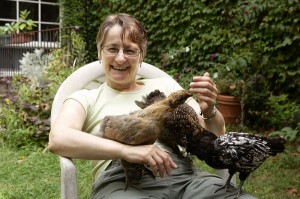
my friend Ruth with the girls
This photo shows my friend Ruth the chick magnet. It really shows how curious and friendly the chicks are. They have been used to being around people, so they flock around us whenever they are out of their coop. They still make cheep cheep sounds, although we get the occasional bwock sound.
9 Weeks Old:

Edie with a beard
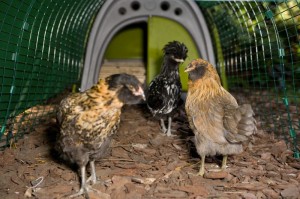
LouLou, Andie and Edie
We got back from a visit to my father in France to discover some of our girls grew beards! Edie, pictured above was the little one who looked like a chipmunk originally. LouLou has grown orange and brown feathers in place of her all-dark baby fluff, and Andie has spectacular black and white feathers and a crazy pompom hairdoo now.
29 Weeks Old:
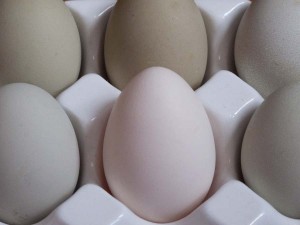
first eggs
We can now fast-forward a bit to when the girls started to lay. LouLou was the first to lay an egg (on Groundhog’s Day) and you can catch up with that in my post here. You can tell when your chicks are about to get ready to lay when their combs turn red. You can see in the photo of Edie above that her comb hasn’t really developed and is quite pale. I can tell which hen laid which egg because each one is a slightly different color. LouLou’s are sage green, Edie’s are a pale blue and Andie’s are white.
We have enjoyed our chickens tremendously and highly recommend chicken keeping to almost anyone. We felt like first-time parents as we watched our chicks grow into hens. We love the rich, “meaty” eggs they give us. How many people have pets that make them breakfast?? What was really important to us was that our “city girl” daughter would grow up knowing where her food comes from, and now she does.
I will write more about the nuts and bolts of keeping city chickens in my next post.

